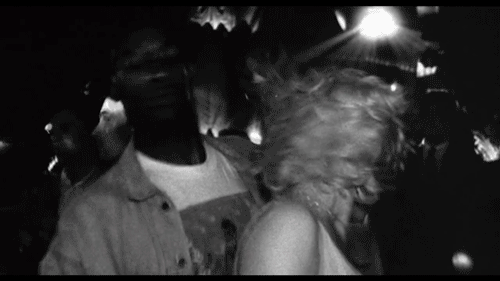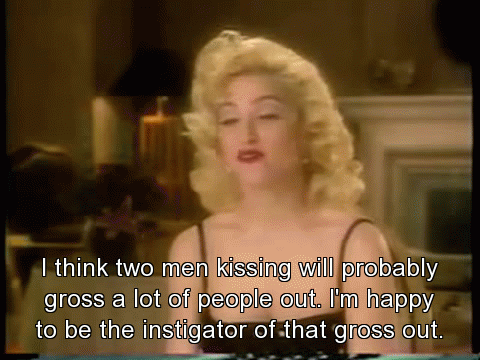Member Since: 4/27/2012
Posts: 9,977

|
'Truth or Dare' unseen footage is lost :(
Madonna’s “Truth Or Dare” Changed A Generation Of Gay People; The Director Takes Us Behind The Scenes
  In the many decades since gay stories have been honestly depicted on the big screen, there are still just a handful of films that can be thought of as transformative viewing experiences, which caused viewers to reflect and change their lives. Among them are The Boys in the Band in 1970, Paris Is Burning in 1990, Brokeback Mountain in 2005, and for many queer people the 1991 documentary Truth or Dare is firmly entrenched in that short list. Director Alek Keshishian’s behind-the-scenes look at Madonna during her wildly successful and chaotic Blond Ambition tour offered the superstars legion of fans an unvarnished peek at her singular version of celebrity and became not only one of the most vivid concerts films ever made, but also the most successful documentary released up to that time, grossing nearly $30 million. Even more provocative to the entertainer’s legion of queer fans was the intimate, yet matter-of-fact glimpse into the lives of her seven backup dancers (six of whom were gay) who became a surrogate family as they trotted around the globe Keshishian’s camera offered. Perhaps Warren Beatty, who was dating Madonna at the time, summed up the atmosphere most expertly with his famous commentary “what point is there existing if it’s off camera.” Madonna didn’t censor her behavior, of course, and neither did her dancers, who queened out, made out and showed off in front of the ever-present cameras. (...) Now approaching its 25th anniversary, Truth or Dare will be screened July 13 during L.A.’s Outfest as part of its Legacy Project, which preserves films that offer indelible images of LGBT people. Queerty chatted with Keshishian about how Madonna chose him to make the film, the chaos of shooting the life of a superstar and their relationship today.
In the many decades since gay stories have been honestly depicted on the big screen, there are still just a handful of films that can be thought of as transformative viewing experiences, which caused viewers to reflect and change their lives. Among them are The Boys in the Band in 1970, Paris Is Burning in 1990, Brokeback Mountain in 2005, and for many queer people the 1991 documentary Truth or Dare is firmly entrenched in that short list. Director Alek Keshishian’s behind-the-scenes look at Madonna during her wildly successful and chaotic Blond Ambition tour offered the superstars legion of fans an unvarnished peek at her singular version of celebrity and became not only one of the most vivid concerts films ever made, but also the most successful documentary released up to that time, grossing nearly $30 million. Even more provocative to the entertainer’s legion of queer fans was the intimate, yet matter-of-fact glimpse into the lives of her seven backup dancers (six of whom were gay) who became a surrogate family as they trotted around the globe Keshishian’s camera offered. Perhaps Warren Beatty, who was dating Madonna at the time, summed up the atmosphere most expertly with his famous commentary “what point is there existing if it’s off camera.” Madonna didn’t censor her behavior, of course, and neither did her dancers, who queened out, made out and showed off in front of the ever-present cameras. (...) Now approaching its 25th anniversary, Truth or Dare will be screened July 13 during L.A.’s Outfest as part of its Legacy Project, which preserves films that offer indelible images of LGBT people. Queerty chatted with Keshishian about how Madonna chose him to make the film, the chaos of shooting the life of a superstar and their relationship today.
 You only had a few music videos on your resume in 1990. How did you earn Madonna’s trust for such a massive, personal project?
You only had a few music videos on your resume in 1990. How did you earn Madonna’s trust for such a massive, personal project?
I don’t know. She just saw the opera I did in which I used some of her music and was surprised by her emotions and reaction to it. It was a very bad video. [Laughs] My parents had taped it. I was almost embarrassed to show it to her. She said to me, “If there’s anything I can do to help you with this, let me know.” Unbeknownst to me, she told her agents, “I want to see everything this kid does.” I didn’t realize that until long after the film was shot. I was staying with her in her apartment in New York and in her library there were individual VHS tapes of all my music videos. She hadn’t gotten a compilation, she’d gotten them one at a time right after they were made. She said, “You shoot dance better than anybody.”
  Did you show her the dancer interviews after you filmed them?
Did you show her the dancer interviews after you filmed them?
When we got back to L.A. Madonna started watching that and all my other footage. I told her there was a movie there. I told her, “This is like a Fellini film. You have the craziest characters around you and you’re like a mother hen.” I knew after Japan what the point of the documentary was going to be. It was so clear to witness it in Japan. I had a lot of resistance. I was a 24-year-old kid. Her advisors were telling her, “What the hell are you doing listening to this kid?” Then she gave me final cut. I told her that if she didn’t it would seem like a puff piece on you. I told her she had to trust me. Obviously my goal wasn’t to make her look bad. I wanted her to look real. I have to give her credit. She was incredibly brave and it was against the advice of a lot of people around her.
  Besides business meetings, did Madonna place any limitations on what she’d let you film?
Besides business meetings, did Madonna place any limitations on what she’d let you film?
She just wouldn’t do anything twice. Today with reality TV you do a run-through, then they film it again and again for coverage so they’re improvising and you know all the beats of the scene. Madonna, if she walked through a door and I didn’t get, I knew not to ask her to do it again because she wouldn’t. She told me, “You can film anything as long as you’re not making me do anything.”
  How did you decide what to include in the final edit?
How did you decide what to include in the final edit?
It was all for the purpose of storytelling. I ended up not using a lot of the bed interviews because it wasn’t necessary for the story I was telling. The first cut I showed her was like three-and-a-half hours long. I clawed it back, but Harvey Weinstein still said I needed to take another 15 minutes out. I said I wouldn’t. He said Jeffrey Katzenberg [then a top-ranking exec at Disney] said we needed 15 minutes cut and I said that’s why Jeffrey Katzenberg doesn’t have this movie. It isn’t a fictional film where we can just lose 15 minutes without the balance being ****ed up. If you don’t have the Chanel scene, you don’t have that levity. You don’t get to experience the mayhem that happens around her, along with the playfulness. If I’d changed anything in the final cut, the whole thing would have collapsed in my opinion.
  You mentioned that you shot more than 200 hours of film. For a lot of gay people that missing footage is like the holy grail. There’s a snippet or two on the internet, but will fans ever get to see all of it?
You mentioned that you shot more than 200 hours of film. For a lot of gay people that missing footage is like the holy grail. There’s a snippet or two on the internet, but will fans ever get to see all of it?
What’s weird is that we don’t even know where it is. That’s how ****ed up it is. We were trying to get a print to the Legacy Project, Miramax owned it then Miramax was bought by Disney, then Disney decided to shut down Miramax and sold the library to these random distributors. So the person who put out the Blu-ray doesn’t even have the neg for us to maintain. I’ve been dealing with Madonna’s management, asking “Where the **** is this stuff?” It must be in some storage somewhere. Unfortunately, it was handed over to her management so I don’t know. I wouldn’t be surprised if it’s discovered a hundred years from now in some office.
  The film is screening at Outfest as part of its Legacy Project. What do you see as the legacy of Truth or Dare?
The film is screening at Outfest as part of its Legacy Project. What do you see as the legacy of Truth or Dare?
It makes me very happy that so many gay adults and young people from all parts of the United States refer to this as their first encounter with being able to see gay men shown in such a positive, almost causal way. She was so comfortable with it. It wasn’t an issue. Then you go to the Gay Pride parade and you’re reminded of all the people who died. At that point you’ve kind of fallen in love with the dancers. I think it’s the legacy of how exposure to homosexuality and for people to understand it’s not a big deal, it’s just the way some people are. They deserve the full range of rights and love and everything else. To me, that’s the proudest achievement of the movie. I don’t think we knew at the time that it would have that impact. It was so matter-of-fact. Then I realized people were shocked by the kiss between the two guys.
 Your film was groundbreaking at the time for the matter-of-fact depiction of the lives of the back-up dancers. Some might even describe it as transformative. I know people who came out to their parents as really young kids after watching the film. One friend told me that seeing the sense of family between Madonna and the dancers prevented him from attempting suicide. Were there conversations about presenting the dancers this way?
Your film was groundbreaking at the time for the matter-of-fact depiction of the lives of the back-up dancers. Some might even describe it as transformative. I know people who came out to their parents as really young kids after watching the film. One friend told me that seeing the sense of family between Madonna and the dancers prevented him from attempting suicide. Were there conversations about presenting the dancers this way?
No, there was no discussion. It’s just the away I shot it. I didn’t think it should be made into a big deal, except for the poignancy and pain of the Pride march. I wanted the rest of it to just be a given. I didn’t want it to be about them being gay. I wanted it to be about them being characters. By doing that it was kind of revolutionary. We made a really gay movie without the subject matter being gayness.
  https://www.queerty.com/madonnas-tru...cenes-20150711
https://www.queerty.com/madonnas-tru...cenes-20150711
|
|
|
|